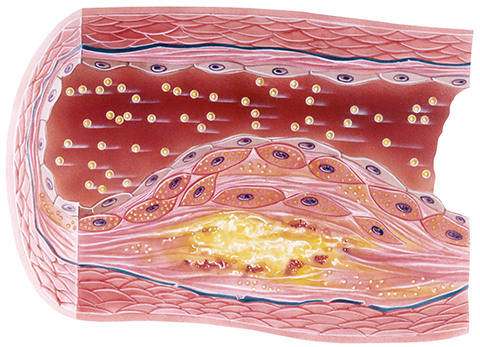From the journals: JLR
What gene stresses endothelial cells? Are smaller fat cells better for your health? Read about how researchers are addressing these questions in the Journal of Lipid Research.
What gene stresses endothelial cells?
Cholesterol homeostasis helps regulate cellular functions in mammals and plays a role in the human body’s structure and metabolism. Understanding cholesterol biosynthesis is important in the context of its imperative role in maintaining a healthy lifestyle. Cholesterol biosynthesis determines cholesterol homeostasis and multiple regulatory mechanisms are in charge of controlling this process. Sterol regulatory element-binding protein 2, or SREBP2, is the prime transcriptional regulator of this complex process.

Cholesterol homeostasis and cellular immunity have a close relationship, regulated by SREBP, which researchers have not thoroughly explored in endothelial cells, or ECs. In diseases such as atherosclerosis, levels of SREBP2 and cholesterol in EC increase, making it more important to study their role in the inflammatory process.
In a recent article published in the Journal of Lipid Research, Joseph Wayne and researchers from the Yale University School of Medicine and the University of Arizona describe how SREBP2 significantly contributes to the overall EC inflammatory response. They also provide the first report of endogenous SREBP2 chromatin immunoprecipitation sequencing, or ChIP-seq, performed in human cells under inflammatory stress.
These researchers showed that loss of SREBP2 inhibits chemokines such as IL6, CXCL1 and CXCL8, which are important for recruitment and activation of leukocytes to the site of injury detected by ECs. SREBP2 knockdown did not affect other classical nuclear factor kappa-light-chain-enhancer of activated B, or NF-kB, genes. This implies that SREBP2 controls a distinct pathway of the EC inflammatory phenotype. They treated the ECs with tumor necrosis factor alpha and performed ChIP-seq, which enabled them to identify two gene targets: class E basic helix- loop-helix protein 40, or BHLHE40, and Krueppel-like factor 6, or KLF6. These two genes are novel targets of SREBP2 binding, and loss of SREBP2 significantly weakened the expression of both. Of the two, KLF6 knockdown more significantly inhibited specific chemokine expression in ECs.
The authors are interested in exploring the role of SREBP2 in diseases such as atherosclerosis by studying the close connection between cholesterol homeostasis and inflammatory phenotypes in ECs.
Are smaller fat cells better for your health?
Obesity and obesity-related chronic diseases are major public health concerns. According to the Centers for Disease Control and Prevention, about 42% of adults and 20% of children in the U.S. are obese. Dysfunctional adipose tissue is a hallmark of obesity. The expansion of adipose tissue can be driven either by the increased size of existing adipocytes (hypertrophy) or by the formation of new adipocytes, or adipogenesis, through the differentiation of precursor cells (hyperplasia). Studies have shown that small adipocytes can impede obesity-associated metabolic disorders. Hyperplasia attempts to reduce adipose tissue remodeling, such as macrophage infiltration and chronic inflammation, caused by obesity-associated hypertrophy. Thus, researchers are becoming more interested in studying adipogenesis for the benefit of metabolic health.
The alpha/beta–hydrolase domain, or ABHD, enzymes, a family of endocannabinoid-degrading enzymes, are important regulators of lipid metabolism and signal transduction. In a recent article published in the Journal of Lipid Research, Mary E. Seramur and a team at Wake Forest University explored the function of ABHD4, a lysophospholipase/phospholipase B enzyme in adipose tissue lipid biology. They used a novel Abhd4 knockout, or KO, pre-adipocyte cell model as well as adipocyte-specific and whole-body Abhd4 KO mice for their study.
Throughout nine days of adipocyte differentiation, the researchers observed increased adipogenesis and lipid accumulation in cells lacking ABHD4 by measuring the triacylglycerol, or TAG, mass, lipid droplets that are stored in cellular lipid droplets. They saw no difference in body weight, fat composition and metabolic outcome such as glucose tolerance in adipocyte-specific and whole-body Abhd4 KO mice. They also did not find any difference in bioactive lipids such as oleoylethanolamide that are responsible for lipolysis, a process that breaks down TAG in both kinds of mice.
The researchers are interested in studying the effect of ABHD4 and specific protein kinase interaction in regulating adipogenesis.
Enjoy reading ASBMB Today?
Become a member to receive the print edition four times a year and the digital edition monthly.
Learn moreGet the latest from ASBMB Today
Enter your email address, and we’ll send you a weekly email with recent articles, interviews and more.
Latest in Science
Science highlights or most popular articles

Mining microbes for rare earth solutions
Joseph Cotruvo, Jr., will receive the ASBMB Mildred Cohn Young Investigator Award at the ASBMB Annual Meeting, March 7–10, just outside of Washington, D.C.

Fueling healthier aging, connecting metabolism stress and time
Biochemist Melanie McReynolds investigates how metabolism and stress shape the aging process. Her research on NAD+, a molecule central to cellular energy, reveals how maintaining its balance could promote healthier, longer lives.

Mapping proteins, one side chain at a time
Roland Dunbrack Jr. will receive the ASBMB DeLano Award for Computational Biosciences at the ASBMB Annual Meeting, March 7–10, just outside of Washington, D.C.

Exploring the link between lipids and longevity
Meng Wang will present her work on metabolism and aging at the ASBMB Annual Meeting, March 7-10, just outside of Washington, D.C.

Defining a ‘crucial gatekeeper’ of lipid metabolism
George Carman receives the Herbert Tabor Research Award at the ASBMB Annual Meeting, March 7–10, just outside of Washington, D.C.

The science of staying strong
Muscles power every movement, but they also tell the story of aging itself. Scientists are uncovering how strength fades, why some species resist it and what lifestyle and molecular clues could help preserve muscle health for life.

